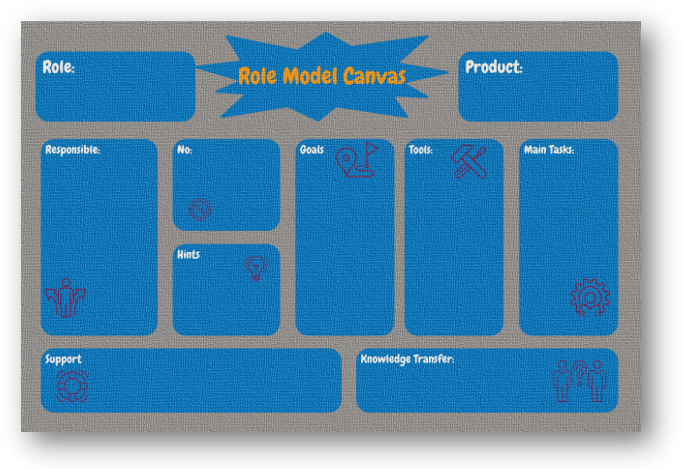Appearance
Role Model Canvas
- Subject
- Agile Roles
- Participants
- The entire agile team
- Facilitator
- Scrum Master / Agile Master

Summary
The Role Model Canvas is a template that defines a role over eight fields.
Definition
The aim of the Role Model Canvas is to visualize the individual roles in the team to define tasks and important properties, such as goals and decision-making authority.
Motivation
A clear definition of roles is essential, be it at the start of the project or when assigning tasks within the team because it ensures security for those involved and serves to avoid potential conflicts.
Results
For every project role there is an one pager that shows what one can expect or claim of a certain role. As the canvas is emerged by the team it is widely accepted.
Benefit
The agile roles must be defined very clearly so that people can work well together on the same goals. Once the roles are taught and lived, people will fill them completely.
Procedure
In the header area of the canvas, you should define the project and the name of the role to be considered. In the middle of the canvas, you will find the "Goals & Mission" field. Here, you write down the purpose of the role. If you cannot state any goals for the role, you should seriously ask yourself whether the role is even needed. On the right, you will find the primary tasks. Note the primary activities of the role here. Be careful not to get into too much details. In the "Responsible and Decides" field, note what this role is responsible for and where and when it has to make decisions. Right next to it, you will find the "NO" field. Here you see what the person in this role shouldn't do. This helps to clearly delimit the role to be defined. The "Tools" field is located between the "Mission and Primary Tasks" fields. Describe role-specific communication channels, communication tools and work equipment here. In the "Support" field, note from whom the role needs support from or who the role actively supports. Proceed in a similar manner in the field of information transfer: Describe with whom and when the role should share its knowledge, and how the exchange of information is regulated. But also make a note from whom and when the role receives or should receive information. Finally, there remains one more field "Notes". This joker field is a placeholder for anything that does not fit into the other categories.
Tools
Flipchart/whiteboard
Hints
Drafts of role descriptions shall be prepared in advance of the workshop and it is considered to ask for support by an expert. To elaborate agreed role definitions with the complete team, an experienced morderator shall lead the workshop, as discussions may become excessive.
See also
Alexander Osterwalder 'Business Model Generation: A Handbook for Visionaries, Game Changers, and Challengers'